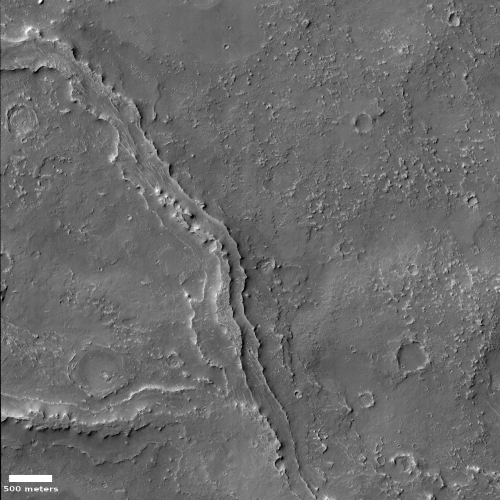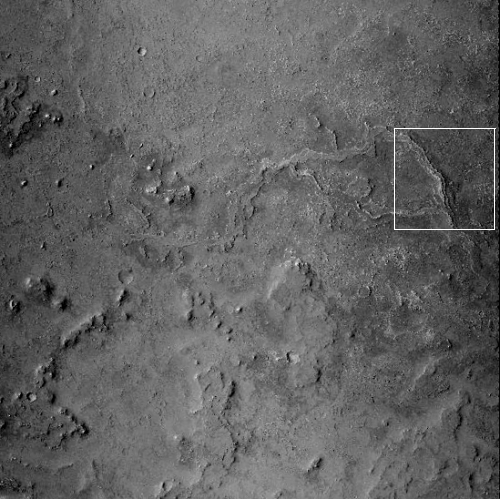Ancient fossil river in the very dry equatorial regions of Mars
Cool image time! The photo to the right, rotated, cropped, and reduced to post here, was taken on August 29, 2021 by the high resolution camera on Mars Reconnaissance Orbiter (MRO). It shows what the scientists label an “inverted channel in Arabia Terra,” a small example of the more than 10,000 miles of fossilized rivers in this region on Mars that scientists have identified using MRO.
They are made of sand and gravel deposited by a river and when the river becomes dry, the channels are left upstanding as the surrounding material erodes. On Earth, inverted channels often occur in dry, desert environments like Oman, Egypt, or Utah, where erosion rates are low – in most other environments, the channels are worn away before they can become inverted. “The networks of inverted channels in Arabia Terra are about 30m high and up to 1–2km wide, so we think they are probably the remains of giant rivers that flowed billions of years ago. [emphasis mine]
Since this fossilized river is located at 11 degrees north latitude, smack in the middle of the dry equatorial regions of Mars, it has certainly been a dry desert for a very long time. You can see how barren the terrain appears by looking at the wider view afforded by MRO’s context camera below.

The context image to the right has been rotated, cropped, reduced, and enhanced to post here. The white rectangle marks the area covered by the high resolution picture above. This photo shows that this ancient upraised river bed is very ancient indeed, as it meanders to the west it fades out somewhat quickly. Moreover, the wider views in the full images of both the high resolution and context camera images emphasizes the barrenness of this terrain.
The overview map below gives the context. Arabia Terra is the largest transition zone on Mars between the northern lowland plains and the cratered southern highlands. For those parts of Arabia located in those equatorial regions — as is this inverted channel — there appears to be no near surface water, with the terrain generally appearing very dry and eroded in most images.
The low erosion rates at this location are emphasized by the fundamental differences between the northern lowland plains and the southern cratered highlands. Unlike the northern lowlands, which apparently have been heavily reshaped — possibly by large ice sheets on or very near the surface — so that many craters have been removed by erosion, the cratered highlands has been relatively undisturbed for billions of years, allowing many more craters from impacts over that time to remain visible.
This lack of erosion in the equatorial cratered highlands suggests that even though Mars has swung through many climate cycles as its rotational tilt shifts back and forth from 11 to 60 degrees, those cycles have not effected the equatorial regions as much. The ebb and flow of ice in the mid-latitude bands of Mars apparently never quite reaches the regions at the equator, or if it does it does so in a much more limited manner.
On Christmas Eve 1968 three Americans became the first humans to visit another world. What they did to celebrate was unexpected and profound, and will be remembered throughout all human history. Genesis: the Story of Apollo 8, Robert Zimmerman's classic history of humanity's first journey to another world, tells that story, and it is now available as both an ebook and an audiobook, both with a foreword by Valerie Anders and a new introduction by Robert Zimmerman.
The print edition can be purchased at Amazon or from any other book seller. If you want an autographed copy the price is $60 for the hardback and $45 for the paperback, plus $8 shipping for each. Go here for purchasing details. The ebook is available everywhere for $5.99 (before discount) at amazon, or direct from my ebook publisher, ebookit. If you buy it from ebookit you don't support the big tech companies and the author gets a bigger cut much sooner.
The audiobook is also available at all these vendors, and is also free with a 30-day trial membership to Audible.
"Not simply about one mission, [Genesis] is also the history of America's quest for the moon... Zimmerman has done a masterful job of tying disparate events together into a solid account of one of America's greatest human triumphs."--San Antonio Express-News
Cool image time! The photo to the right, rotated, cropped, and reduced to post here, was taken on August 29, 2021 by the high resolution camera on Mars Reconnaissance Orbiter (MRO). It shows what the scientists label an “inverted channel in Arabia Terra,” a small example of the more than 10,000 miles of fossilized rivers in this region on Mars that scientists have identified using MRO.
They are made of sand and gravel deposited by a river and when the river becomes dry, the channels are left upstanding as the surrounding material erodes. On Earth, inverted channels often occur in dry, desert environments like Oman, Egypt, or Utah, where erosion rates are low – in most other environments, the channels are worn away before they can become inverted. “The networks of inverted channels in Arabia Terra are about 30m high and up to 1–2km wide, so we think they are probably the remains of giant rivers that flowed billions of years ago. [emphasis mine]
Since this fossilized river is located at 11 degrees north latitude, smack in the middle of the dry equatorial regions of Mars, it has certainly been a dry desert for a very long time. You can see how barren the terrain appears by looking at the wider view afforded by MRO’s context camera below.

The context image to the right has been rotated, cropped, reduced, and enhanced to post here. The white rectangle marks the area covered by the high resolution picture above. This photo shows that this ancient upraised river bed is very ancient indeed, as it meanders to the west it fades out somewhat quickly. Moreover, the wider views in the full images of both the high resolution and context camera images emphasizes the barrenness of this terrain.
The overview map below gives the context. Arabia Terra is the largest transition zone on Mars between the northern lowland plains and the cratered southern highlands. For those parts of Arabia located in those equatorial regions — as is this inverted channel — there appears to be no near surface water, with the terrain generally appearing very dry and eroded in most images.
The low erosion rates at this location are emphasized by the fundamental differences between the northern lowland plains and the southern cratered highlands. Unlike the northern lowlands, which apparently have been heavily reshaped — possibly by large ice sheets on or very near the surface — so that many craters have been removed by erosion, the cratered highlands has been relatively undisturbed for billions of years, allowing many more craters from impacts over that time to remain visible.
This lack of erosion in the equatorial cratered highlands suggests that even though Mars has swung through many climate cycles as its rotational tilt shifts back and forth from 11 to 60 degrees, those cycles have not effected the equatorial regions as much. The ebb and flow of ice in the mid-latitude bands of Mars apparently never quite reaches the regions at the equator, or if it does it does so in a much more limited manner.
On Christmas Eve 1968 three Americans became the first humans to visit another world. What they did to celebrate was unexpected and profound, and will be remembered throughout all human history. Genesis: the Story of Apollo 8, Robert Zimmerman's classic history of humanity's first journey to another world, tells that story, and it is now available as both an ebook and an audiobook, both with a foreword by Valerie Anders and a new introduction by Robert Zimmerman.
The print edition can be purchased at Amazon or from any other book seller. If you want an autographed copy the price is $60 for the hardback and $45 for the paperback, plus $8 shipping for each. Go here for purchasing details. The ebook is available everywhere for $5.99 (before discount) at amazon, or direct from my ebook publisher, ebookit. If you buy it from ebookit you don't support the big tech companies and the author gets a bigger cut much sooner.
The audiobook is also available at all these vendors, and is also free with a 30-day trial membership to Audible.
"Not simply about one mission, [Genesis] is also the history of America's quest for the moon... Zimmerman has done a masterful job of tying disparate events together into a solid account of one of America's greatest human triumphs."--San Antonio Express-News




This is, really, beyond human comprehension:
” . . . the remains of giant rivers that flowed billions of years ago.”
“The low erosion rates at this location . . .” The post references Earthly locations, but ‘billions’ of years?
The state-of-the-art in Mars exploration has gone, in the lifetimes of many, from a fuzzy disc, to a place where terrain is seen from ground-level in hi-def.
Suggest a ‘V-Prize’; design a rover that can survive on Venus.
emphasizes the barrenness of this terrain
I was going to quibble with “barrenness” since the entire planet is a barren wasteland, then I noticed the noun. Does Mars have terrain?
I’m in favor of “yes”. Creating different words for “dirt” depending on the location it’s found seems unhelpful. Content (e.g. loam vs regolith) makes more sense.
Although, what’s the difference between “terrain” and “landscape”?
Some planets get fossilized critters, some get fossilized river beds and deltas. Poor Mars. Maybe there are critters in your rivers.
markedup2:
“The Martians have 60 words for ‘dirt'”
Encyclopedia Sol
‘Landscape’ has to be tended: ‘terrain’ just lays around.